Visit Napier Museum In Thiruvananthapuram On Your Trip To Kerala In 2025
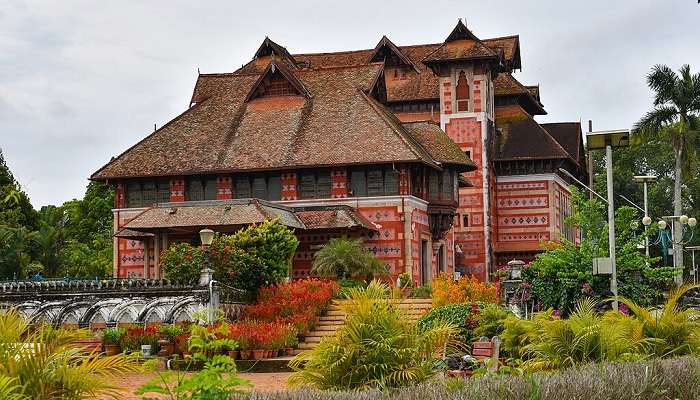
Nestled in the heart of Thiruvananthapuram, Kerala’s capital city, the Napier Museum stands as a testament to architectural brilliance and cultural heritage. Napier Museum in Trivandrum is an amalgamation of South Indian, Mughal, Chinese, and Italian architectural styles and captivates visitors with its striking red-brick exterior and ornate roof. Named after Lord Napier, the former Governor of Madras, the museum houses a treasure trove of ancient artefacts, bronze idols, temple chariots, and ivory carvings. Its natural history collection and intricate Tanjore paintings offer glimpses into India’s rich past.
About Napier Museum
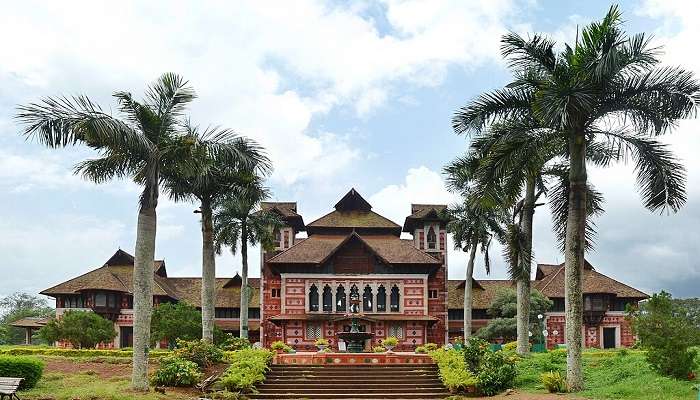
The Napier Museum, situated in Thiruvananthapuram is a distinguished institution celebrated for its extensive collection of both art and natural history. Adjacent to the museum is the Trivandrum Zoo, a historic zoological garden spanning 55 acres (220,000 m²) and established in 1857. This sprawling complex also includes the Sree Chitra Art Gallery, inaugurated in 1935, which houses a diverse array of artworks.
Managed by the Department of Museums and Zoos under the Kerala Department of Cultural Affairs, these institutions play a vital role in preserving and presenting cultural and natural heritage to the public, contributing significantly to the region’s cultural landscape and educational outreach.
Also Read: Shangumugham Beach
History Of Napier Museum
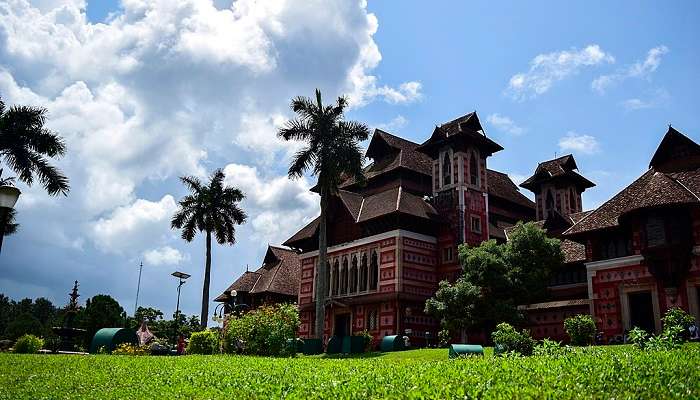
The Napier Museum Thiruvananthapuram Kerala has a history dating back to the mid-19th century. The original building was constructed in 1857 during the reign of Uthram Thirunal Marthanda Varma but was later demolished in 1874 during Ayilyam Thirunal’s rule to make way for a new museum.
In 1872, Robert Chisholm, a consulting architect appointed by the Governor of Madras, designed the new museum. Construction began and was completed by 1880, opening to the public. It was named after Francis Napier, the Governor of Madras and the 10th Lord Napier.
Architecturally, the Napier Museum is notable for its Indo-Saracenic style, blending Indian, Islamic, and European architectural techniques. The building’s natural ventilation system has historically maintained comfortable indoor conditions without air conditioning.
In 2016, an annex was added to the museum complex, but it faced issues like mold, insects, and corrosion due to insufficient windows and ventilation. Since 2017, efforts have focused on reviewing and rebuilding the annexe to resolve these problems. The main Napier Museum building has also been renovated to preserve its historical significance and functionality for future generations. Overall, the Napier Museum is a testament to Thiruvananthapuram’s rich architectural and historical heritage.
Architecture Of The Napier Museum
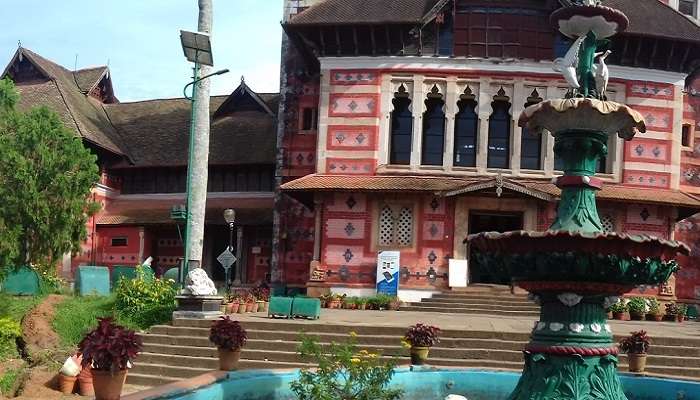
Napier Museum in Trivandrum, nestled amidst lush greenery in Thiruvananthapuram is a captivating blend of architectural styles that narrate a tale of cultural convergence. Encircled by a garden showcasing a myriad of trees and vibrant flowers, the museum boasts the pride of Kerala’s oldest rubber tree, transplanted from Ceylon in 1876 under the auspices of Visakham Thirunal, adding a living historical dimension to its surroundings.
Approaching the central tower, one is struck by its distinctive appearance—a striking red-and-white structure crowned with a Gothic roof. However, there is scholarly contention over this classification, with some asserting that its design was influenced more by the stacked roofs of the Kuthira Malika Palace rather than pure Gothic elements. Indeed, the Maharajah himself expressed dissatisfaction with the museum’s departure from the purist Gothic style favoured by its architect, Chisholm.
Despite these debates, the Napier Museum’s architecture remains a harmonious amalgamation of Indian, Chinese, Kerala, and Mughal architectural traditions. The interior is organised around three grand halls connected by expansive corridors adorned with lofty columns, numerous gables, and intricate ceiling panels. The craftsmanship of the woodwork is exemplary, complemented by stained glass windows and artistically painted walls that enchant visitors inside and out.
Embodying elements of the Indo-Saracenic style, the museum not only captivates aesthetically but also functions practically, providing natural ventilation that renders it a fantastic retreat on hot summer days. In this architectural marvel, history, art, and utility converge seamlessly amidst Kerala’s natural beauty.
Related Posts: Places To Visit In Mananthavady
Collection At Hill Palace Museum
Napier Museum Thiruvananthapuram Kerala boasts a diverse and extensive collection spanning over 550 artefacts of profound historical and archaeological significance. They are as follows:
1. Ancient Coins Collection
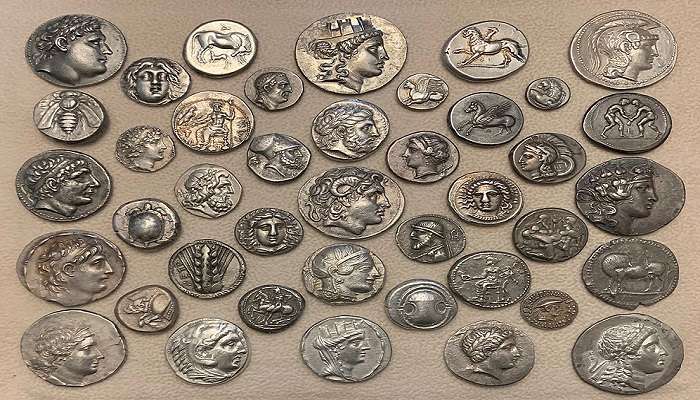
The Napier Museum boasts a remarkable collection of ancient coins, comprising over 5000 pieces that span a wide range of historical periods and dynasties. These coins provide valuable insights into the economic, political, and cultural history of South India and beyond. Among the highlights are Kushan, Chera, Chola, Hoysala, Satavahana, Pandya, Vijayanagara, and Mysore Nawab coins, each representing different eras and rulers. They are tangible artefacts of trade routes, regional power shifts, and cultural interactions over millennia.
2. Bronze Images And Sculptures
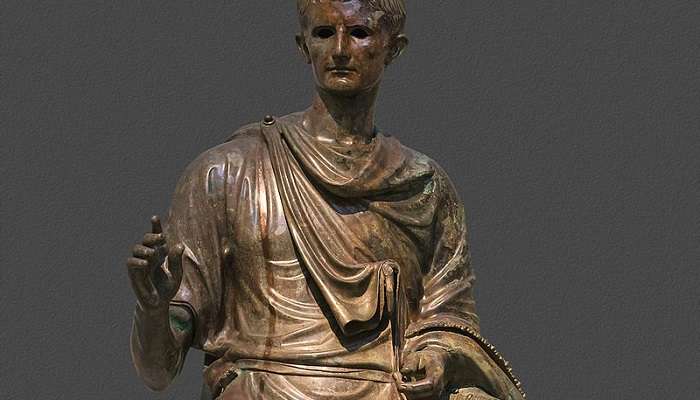
The museum’s collection of bronze sculptures is particularly notable for its craftsmanship and artistic diversity. It includes religious icons such as Hindu gods and goddesses, ceremonial objects, and secular figures. The bronze image collection includes notable pieces such as Sastha, Surya, Nataraja, Bhuvaraha Murthi (Lakshmi Varaha), Parvathy, Venugopala Murthi, Buddha, Devi, Kankala Murthi, Devotee, Aghora Bhairava, Ardhanareeswara, Bhairava, Devi (Vidyasakthi), Sakthi Ganapathi, Ganesha, Garuda, Nandikeswara/Adhikaaranandi, Parshvanatha, Siva.
Related Posts: Things To Do In Pathanamthitta
3. Wooden Sculptures and Carvings

The wooden sculptures and carvings at the Napier Museum reflect the region’s traditional craftsmanship and aesthetic sensibilities. Specific highlights include a multi-chambered jewellery box, durbar chairs, the Thirunandikkara Mandapam, a temple car, a model of the Guruvayoor Temple, sculptures such as Thripuranthaka Murthi, Brahma, Mahishasura, Narasimha, Dwarapalaka, Dakshina Murthi, Manmata, Indra, Durga, and Koothambalam, as well as the Pushpa Vimanam. Additionally, the museum houses Sree Rama and Hanuman figures, a textile box, and the impressive Mahishasura Mardini sculpture.
4. Stone Sculptures
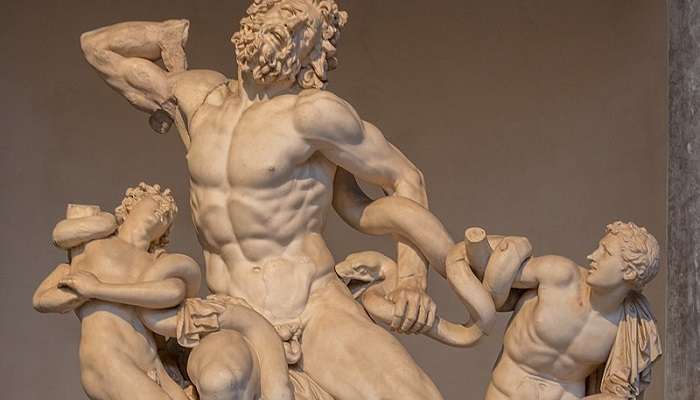
The museum’s collection of stone sculptures encompasses many artefacts, ranging from monumental temple sculptures to smaller decorative pieces. The museum showcases a variety of iconic figures. These include multiple representations of Buddha, Vishnu, Bodhisattva, Devi, Mahishasura Mardini, Siva, Veerabhadra, Marble Buddha, Sastha, Agastya, Kaliya Krishna, and Bhairava. These sculptures depict various gods, goddesses, mythical creatures, and human figures carved with precision and artistic finesse.
Related Posts: Aroor Temple
5. Ivory Carvings
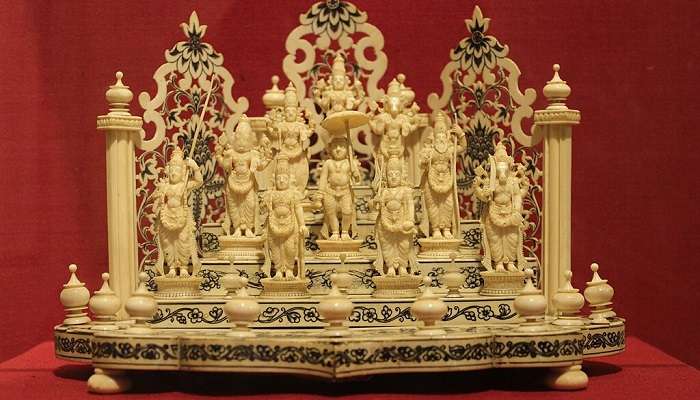
The Napier Museum houses a splendid collection of ivory carvings showcasing intricate craftsmanship and artistic expression. Among these are depictions such as Buddha and Sujatha, Ananthasayanam, Apsaras, Kumbha Kanyaka, Gopalakrishnan, Lakshmi, St. George, Ganapathi, Mahishasura Mardini, Nataraja, Saraswathi, Shiva, Shivaparvathy, Sreerama Group, and various others including intricately carved heads and a hand fan, tusks of animals, a concentric ball, a crucifix, a vase, and representations of Venugopala and Radha Krishna. These royal collectables and diverse historic items enrich the museum’s portrayal of cultural heritage, spanning diverse epochs and artistic traditions.
6. Musical Instruments

The museum’s collection of musical instruments highlights the rich cultural heritage of South India’s musical traditions. Instruments such as the Nagaswaram (wind instrument), Veena (string instrument), and Panchavadyam (percussion ensemble) are prominently displayed. These instruments serve as tools for musical expression and embody cultural identity and historical continuity, with each instrument playing a unique role in traditional performances and rituals.
7. South East Asian Gallery
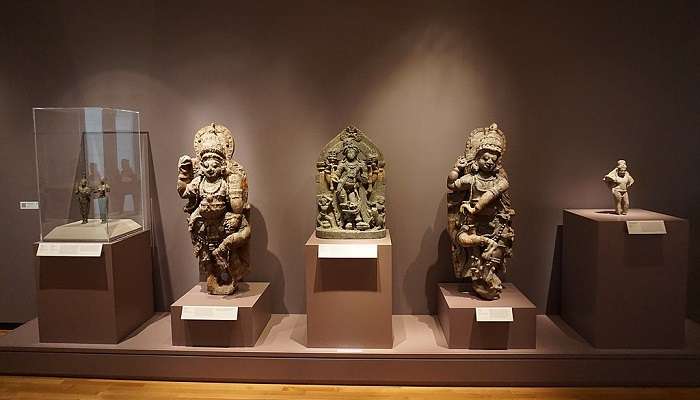
Besides its Indian collections, the Napier Museum features Southeast Asian artefacts in its dedicated gallery. These include objects like the Lapis Lazuli Lion and Green Celadon Dish, showcasing cultural exchanges and historical connections between India and its neighbouring regions. The gallery offers insights into artistic styles, trade networks, and cultural interactions that have shaped the region’s history over centuries.
Each collection at the Napier Museum is meticulously curated to provide visitors with a comprehensive understanding of South India’s diverse cultural heritage, which spans art, history, religion, and craftsmanship over millennia.
Related Posts: Wayanad Heritage Museum
Napier Museum Timings, Entrance Fees, and Best Time to Visit

Napier Museum timings range from 10:00 to 16:45 every day except Mondays, Wednesday forenoons, and on specific holidays such as 26th January, 15th August, Thiruvonam, and Mahanavami. Entry fees for Napier Museum tickets are ₹ 12 for individuals above 12 years old, ₹ 10 for those below 12, and car parking is available for ₹ 150. It offers a glimpse into its rich architectural heritage and various exhibits amidst serene surroundings in Thiruvananthapuram, Kerala.
If you’re planning a visit, the best time to explore this historic museum is generally between October and February. During these months, the weather in Trivandrum is most pleasant, with moderate humidity and cooler temperatures. Whether you’re interested in art, natural history, or unique architecture, the Napier Museum awaits your discovery!
How to Reach Napier Museum?

The Napier Museum, located in Trivandrum, Kerala, is accessible through various modes of transportation. Let’s explore each option:
By Air
The Napier Museum in Trivandrum, Kerala, is conveniently accessible via Trivandrum International Airport, approximately 6 Km away. Upon arrival, visitors can easily find taxis or auto-rickshaws for a short journey to the museum.
By Train
Thiruvananthapuram Central Railway Station is the closest railway station to the Napier Museum, about 4 Km away. From here, travellers can take local taxis or buses for a quick and straightforward commute to the museum.
By Road
For those travelling by road, the Napier Museum is located near the Mascot Hotel in Trivandrum. The Trivandrum Bus Station is approximately 4 Km away, offering bus services and taxi options to reach the museum from various parts of the city conveniently.
You May Also Like To Read: Jew Town
The Napier Museum is a testament to Kerala’s rich cultural heritage and architectural brilliance. Its unique mix of Indian, Chinese, and Kerala styles and vast collection of artefacts make it a must-visit destination for history enthusiasts and art lovers alike. As you plan your next adventure, consider immersing yourself in the Napier Museum’s captivating world and Kerala’s vibrant culture. Are you ready to explore this architectural marvel and experience Kerala’s diverse heritage firsthand? So, why wait? Book your trip to Kerala today and embark on a journey through time at the Napier Museum. Don’t miss the opportunity to create lasting memories in God’s own country!
For our editorial codes of conduct and copyright disclaimer, please click here.
Cover Image Credit: Prasanth Prakash for wikimedia commons
Frequently Asked Questions About Napier Museum
Why is the Napier Museum famous?
The Napier Museum is renowned for its vast collection of artefacts, encompassing a diverse range of cultures and historical periods. It houses treasures from ancient Egypt, Greece, Rome, India, and other parts of Asia, alongside a significant collection of Mughal and Rajput paintings. The museum also garners acclaim for its archaeological finds, including sculptures, bronzes, and textiles.
How much time is required for the Napier Museum?
The time you need to explore the Napier Museum depends on your interests and how in-depth you want to delve into the exhibits. Generally, allocating 2-3 hours is sufficient to get a good overview of the museum's collection. However, if there are specific sections that particularly interest you, you might want to set aside more time.
Who built Napier?
The museum is named after Lord Napier, the Governor General of Madras at the time. Impressed by traditional Kerala-style architecture, Lord Napier, in 1872 CE, commissioned Robert Fellowes Chisholm, the architect of the Government of Madras, to construct this royal structure.
Are there any facilities for visitors?
The Napier Museum likely offers basic amenities for visitors, like restrooms and drinking water. There might also be a gift shop selling souvenirs and a cafe with light refreshments, but it's best to check the museum's website or social media for confirmation.
Can I take photographs?
Yes, photography is allowed in some museum areas, but there might be a fee. Flash photography and tripods are usually not allowed. Confirming the current photography policy when you arrive at the museum is always best.
People Also Read:
The Dhangarhi Gate And Museum The Museum Of Siam In 2024 Bloemfontein Museums

With a passion for exploring and travelling to the roads long forgotten, experience the world through enthralling stories and adventures. Join me as I share my experiences at some of the world’s most popular tourist destinations and quench that pestering curiosity with something exciting!











